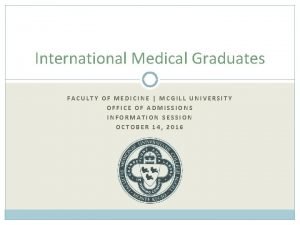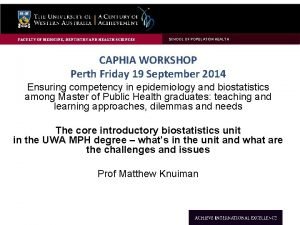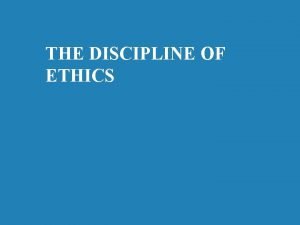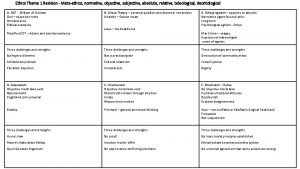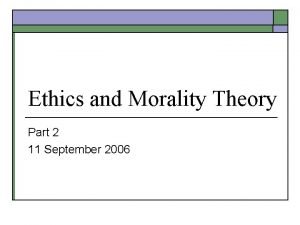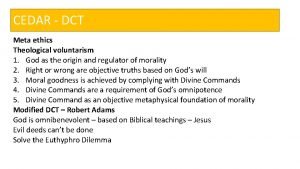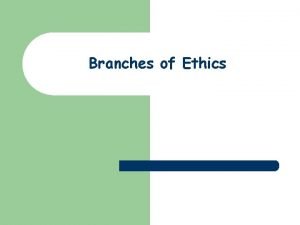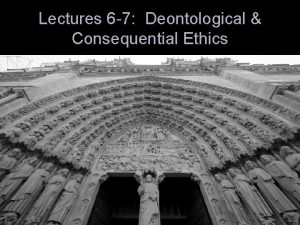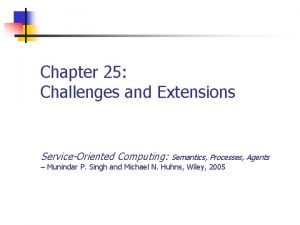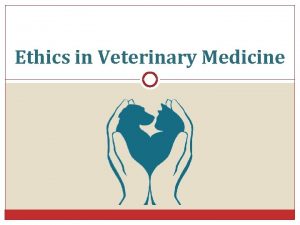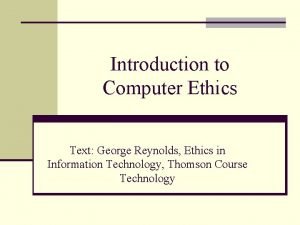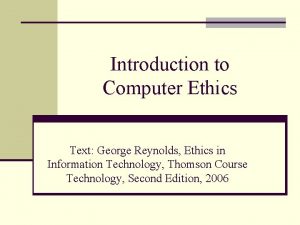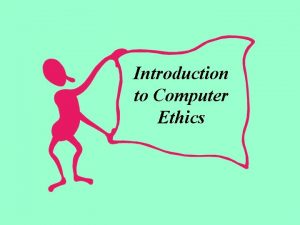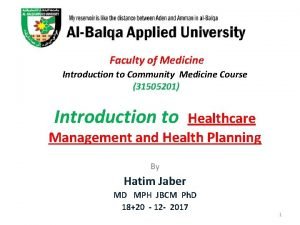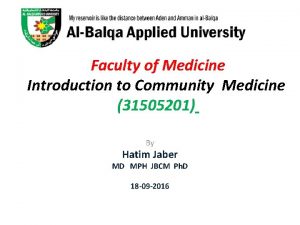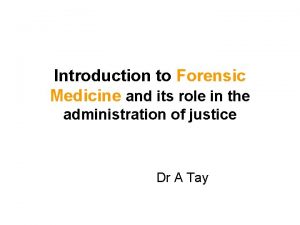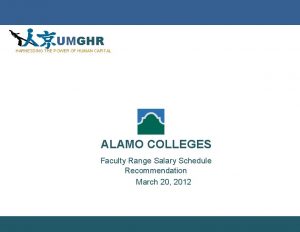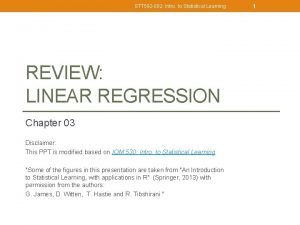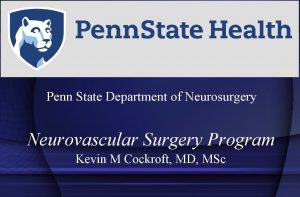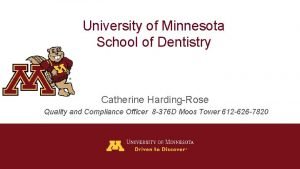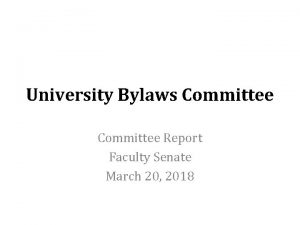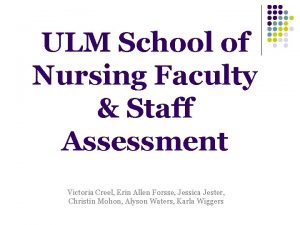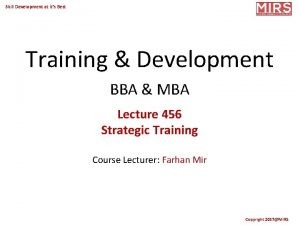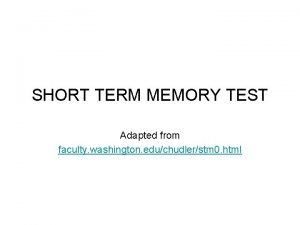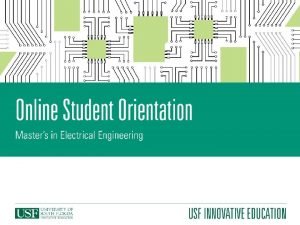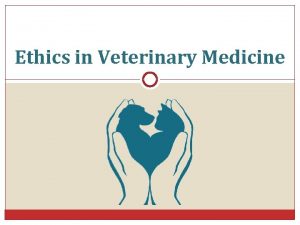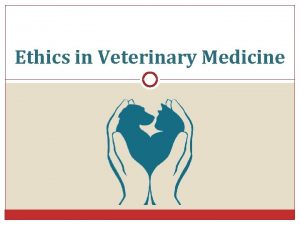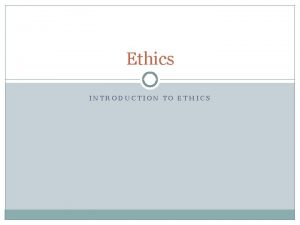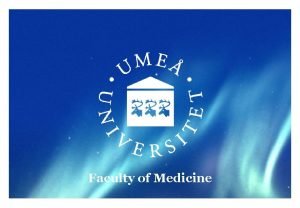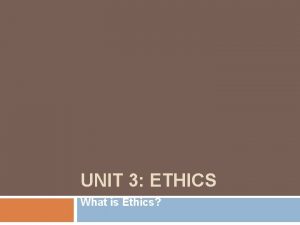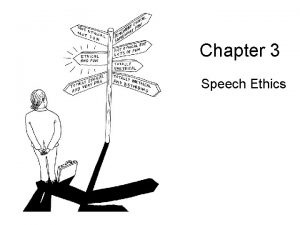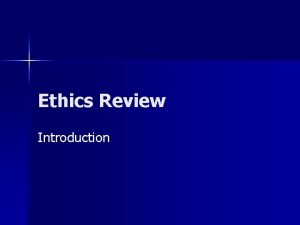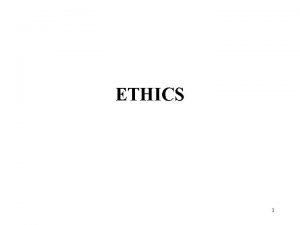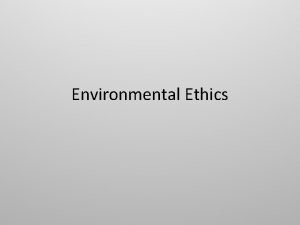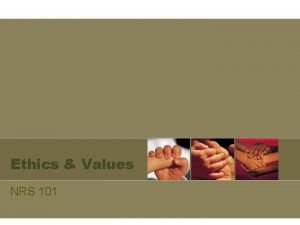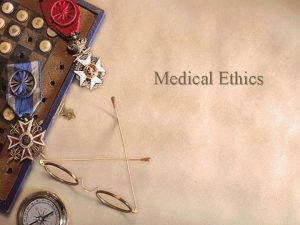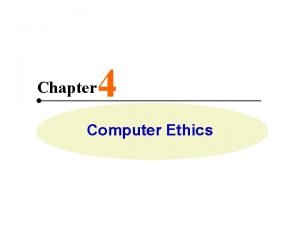Faculty of Medicine Introduction to Ethics in Medicine






















































































- Slides: 86

Faculty of Medicine Introduction to Ethics in Medicine By Hatim Jaber MD MPH JBCM Ph. D 27 -6 -2018 1

Presentation outline 27 -6 -2018 Time Introduction to Ethics in Medicine 10: 00 to 10: 20 Types of Ethics, The principles In Medical Ethics 10: 20 to 10: 35 DUTIES OF MEDICAL PRACTITIONERS 10: 35 to 10: 50 Medical Law & Ethics 11: 00 to 11: 25 ﻗﺎﻧﻮﻥ ﺍﻟﻤﺴﺆﻮﻟﻴﺔ ﺍﻟﻄﺒﻴﺔ 11: 25 to 11: 50 2

“ Whatsoever things I see or hear, concerning the life of men, in my attendance on the sick. . . I will keep silence thereon, counting such things to be as sacred secrets. “ Hypocratic Oath

Ethics ethics refers to standards of behavior that tell us how human beings ought to act in the many situations in which they find themselves as friends, parents, children, citizens, businesspeople, teachers, professionals, and so on.


Ethics are … • • • Moral Principles What is good and bad What is right and wrong Based on value system Ethical norms are not universal – depends on the sub culture of the society

Ethics are not … Ethics is not the same as feelings Ethics is not religion Ethics is not following the law Ethics is not following culturally accepted norms • Ethics is not science • •

ETHICS / MORAL • The oldest scientific and philosophical discipline • Demarcation: science / subject ethics moral (gr. ethos = custom, (lat. mos = character, practice) nature) - Ethics – discipline about moral or philosophy on moral - Moral – system of norms or rules, written or not, about human behavior

Ethics - signifies moral values Medical ethics – moral principles for registered medical practitioners in their dealings with each other, their patients and state

Ethics---Historically • Medical ethics may be traced to guidelines on the duty of physicians such as the Hippocratic oath • A physician must recognize responsibility to patients first and foremost, as well as to society, to other health professionals, and to self.

Hammurabi Code 1750 BC THE EVOLUTION OF Hippocratic Oath 450 MEDICAL ETHICS ISLAMIC SCHOLARS

MEDICAL ETHICS CODES AROUND THE WORLD MEDICAL ASSOCIATION BRITISH MEDICAL ASSOCIATION AMERICAN MEDICAL ASSOCIATION 1 5

Why Teach Ethics? Much debated: “ if you can’t evaluate it, don’t teach it”

Types of Ethics • Medical Ethics: Clinical obligations – fidelity first to patients’ interests – telling the truth (cancer, errors) • Professional Ethics: Obligations of the profession – self-regulation – education of self and others • Bioethics: Guides for public policy – gene technology, stem cell research – health system reform

The Ethical Core of Medicine The patient’s good is paramount The Moral Context of the Doctor-Patient Relationship Honesty and integrity Mutual respect Trust Empathy Mutual goals

Goals of Teaching Ethics Philosophy of medicine/principles Sensitize students to value issues Teach moral reasoning Highlight the uniqueness of patientdoctor relationship Place medicine in broader, social, professional perspective Not to teach students to be ethical.

Topics in Clinical Ethics Philosophy and medicine Informed Consent Truth-telling Confidentiality Justice, resource allocation: macro/micro Transplantation Ethics Ethical issues in HIV/AIDS Maternal-fetal conflicts Family-dispute resolution Ethical issues in surgery Theories and principles Brain death, dying, DNR Advance directives Disclosing mistakes Ethical issues in pediatrics Ethical issues in psychiatry Ethical issues in intensive care Patients who refuse food/water Research on human subjects Ethics in geriatric care Ethics in stem-cell research

Process of making ethical decisions 1. Awareness—Is there a moral issue here? - What is its nature? How important? 2. What are the facts? 3. What are the issues? 4. What rules or values apply here? 5. To whom or what do I owe a duty? 6. How should they be applied? 7. Who needs to decide and act? Who ought to? 8. To what am I obligated because of role/position? 9. What are the consequences? 10. What are the options? !

Professionalism Altruism- best interests of patient: not self-interests Accountability- patient, society, profession Excellence- exceed ordinary expectations Duty- acceptance of a commitment to service Honor and integrity- highest standards of behavior, be fair, truthful, keep promises, meet commitments Respect for persons- humanism, collegiality, dignity Confidentiality-communications are private

Ethical Dilemma: • Value conflicts, no clear consensus as to the “right” thing to do. A conflict between moral obligations that are difficult to reconcile and require moral reasoning. • Situations necessitating a choice between two equal (usually undesirable) alternatives. 20

Potential Conflicts of Obligation ¨The physician as healer –Goal: the good of the patient • The physician as scientist – Goal: the good of science • The physician as businessman – Goal: make money • The physician as private person – Goal: the good of self, family, community, etc.



Clinical Ethics Physicians vs non-physicians Consensus : physicians with adequate ethics training Benefits of clinician teaching ethics - credibility with students - serve as role models - bring relevant experience/ cases

The content of clinical ethics includes 1 -specific issues such as: • truth-telling, • informed consent, • end of life care, • palliative care, • allocation of clinical resources, • and the ethics of medical research. 2 -the study of the doctor-patient relationship, including such issues as: honesty, competence, integrity, and respect for persons.

Components of Medical Ethics • The Physician -- Patient Relationship • The Physician -- Physician Relationship • The relationship of the Physician to the System of Healthcare • The Relationship of the Physician to Society 26

Principles of Medical Ethics The good of the patient is paramount – TRUST must be nurtured before all else • Avoid conflicts of interest (COI) • Avoid perception of COI • Respect rights of pt – safeguard confidentiality – respect self-determination • communicate honestly with all • maintain competence


THE PRINCIPLES IN MEDICAL ETHICS 1. 2. 3. 4. 5. 6. 29 The Principle of Non-Maleficence The Principle of Beneficence The Principle of Autonomy The Principle of Veracity The Principle of Confidentiality(or Fidelity) The Principle of Social Responsibility and Justice

The Principle of Autonomy • People have the right to control what happens to their bodies. • This principle simply means that an informed, competent adult patient can refuse or accept treatments, drugs, and surgeries according to their wishes. • People have the right to control what happens to their bodies because they are free and rational. • These decisions must be respected by everyone, even if those decisions aren’t in the best interest of the patient. 30

Autonomy • Patient has freedom of thought, intention and action when making decisions regarding health care procedures • For a patient to make a fully informed decision, she/he must understand all risks and benefits of the procedure and the likelihood of success.

Autonomy • Always respect the autonomy of the patient - then the particular patient is free to choose • Such respect is not simply a matter of attitude, but a way of acting so as to recognize and even promote the autonomous actions of the patient. • The autonomous person may freely choose loyalties or systems of religious belief that may adversely affect him

Autonomy • The patient must be informed clearly the consequences of his action that may affect him adversely. • Desiring to "benefit" the patient, the physician may strongly want to intervene believing it to be a clear "medical benefit. “ • The physician has a duty to respect the autonomous choice of the patient, as well as a duty to avoid harm and to provide a medical benefit.

Autonomy • But the physician should give greater priority to the respect for patient autonomy than to the other duties. • However, at times this can be difficult because it can conflict with the paternalistic attitude of many health care professionals.

Autonomy • In the case of a child, the principle of avoiding the harm of death, and the principle of providing a medical benefit that can restore the child to health and life, would be given precedence over the autonomy of the child's parents as surrogate decision makers.

The Principle of Beneficence • Requires that the procedure be provided with the intent of doing good for the patient involved. • Demands that health care providers develop and maintain skills and knowledge, continually update training, consider individual circumstances of all patients, and strive for net benefit. • patient’s welfare as the first consideration • All healthcare providers must strive to improve their patient’s health, to do the most good for the patient in every situation. • what is good for one patient may not be good for another, so each situation should be considered individually. 36

Beneficence • The practitioner should act in “the best interest” of the patient - the procedure be provided with the intent of doing good to the patient • This needs health care provider to, - develop and maintain skills and knowledge by continually updating training - consider individual circumstances of all patients

The Principle of Non-Maleficence • Requires that a procedure does not harm the patient involved or others in society. Concern about: • first do no harm • Sanctity ﺣﺮﻣﺔ of life • be aware of the doctrine of double effect, where a treatment intended for good unintentionally causes harm. 38

Non maleficence • “Above all, do no harm, “ – Make sure that the procedure does not harm the patient or others in society • When interventions undertaken by physicians create a positive outcome while also potentially doing harm it is known as the "double effect. " Eg, . the use of morphine in the dying patient. eases pain and suffering while hastening the demise through suppression of the respiratory drive

Non maleficence • Physicians are obligated not prescribe medications they know to be harmful. • Some interpret this value to exclude the practice of euthanasia ﺍﻟﻘﺘﻞ ﺍﻟﺮﺣﻴﻢ • Violation of non-maleficence is the subject of medical malpractice litigation

The Principle of Veracity • Truth telling • Obligation to full and honest disclosure 41

The Principle of Confidentiality • Based on loyalty and trust • Maintain the confidentiality of all personal, medical and treatment information • Information to be revealed with consent and for the benefit of the patient • Except when ethically and legally required • Disclosure should not be beyond what is required 42

Justice • Justice is a complex ethical principle, with meanings that range from the fair treatment of individuals to the equitable allocation of healthcare dollars and resources. • Justice is concerned with the equitable distribution of benefits and burdens to individuals in social institutions, and how the rights of various individuals are realized. • Allocating scarce medical resources. • Be able to justify your actions in every medical situation. 43

Justice • The distribution of scarce health resources, and the decision of who gets what treatment “fairness and equality” • The burdens and benefits of new or experimental treatments must be distributed equally among all groups in society

Justice • The four main areas that Health care provider must consider when evaluating justice 1. Fair distribution of scarce resources 2. Competing needs 3. Rights and obligations 4. Potential conflicts with established legislations

Ethical Issues in Modern Healthcare In modern healthcare and research, value conflicts arise where often there appears to be no clear consensus as to the “Right thing to do. ” These conflicts present problems requiring moral decisions, and necessitates a choice between two or more alternatives. Examples: • Should a parent have a right to refuse immunizations for his or her child? • Does public safety supersede an individual’s right? 46

Ethical Questions? ? ? ? ? • Should children with serious birth defects be kept alive? • Should a woman be allowed an abortion for any reason? • Should terrorists be tortured to gain information possibly saving hundreds of lives? • Should health care workers be required to receive small pox vaccination? • Who should get the finite number of organs for transplantation? 47

Conclusions • Medical ethics is a central and obligatory part of a medical curriculum. • Medical ethics cannot by itself give the correct sense of morality necessary for the medical profession. • Medical ethics can learn students to analyse ethical problems. • Medical ethics can confront the analysis of the clinical problem with human rights. • But: Best training is the visibility of the virtuous physician or “rerum omnium magister usus”(the habit is the master of all things)

Medical Law & Ethics

Healthcare Practitioner Ethics examples of ethical standards • Demonstration of the Best of Manners 1. Truthfulness 2. Honesty and Integrity 3. Humbleness and Respect for Others 4. Patience and Forbearance 5. Passion and Love 6. Moderation and Fairness • Self-accountability • Avoidance of Trivialities and Pettiness

DUTIES OF MEDICAL PRACTITIONERS towards patient 1. 2. 3. 4. 5. 6. 7. 8. 9. 10. Treatment of patient is implied contract Duty to sick Duty to continue treatment Duty to earn confidence Duty to children and infirm Charge for professional service Right to choose a patient Duty to give proper directions Duty to offer proper regime of treatment Duty to notify communicable diseases 11. 12. Duty as regards result of examination Examination and consent

Duties of Healthcare Practitioner Towards Patients (A) Good Treatment of Patient 1. Being welcoming by smiling at patients. 2. Listening attentively to patient’s complaints and empathising with his/her suffering. 3. Being discreet when asking a patient questions related to his/her condition by choosing the most appropriate words for the situation which does not embarrass the patient, unless needed, especially when other people or patients are near. 4. Show humility and refrain from arrogance, demeaning, mocking, sarcasm towards a patient, regardless the patient’s scientific or cultural status. 5. Respect the patients’ points of view, understand their customs and social norms, especially in relation to their personal affairs; but this does not mean not to advise them appropriately. 6. Fairness in the treatment of all patients with no discrimination against them in the level of healthcare based on the differences of their social status or based on personal feelings towards (or against) them. 7. Gentle handling of all patients while performing physical examinations. 8. Refrain from committing religiously forbidden acts, such as unnecessary exposure of patient’s private parts, staying alone with a colleague or a patient of the opposite sex, as will be detailed later. 9. Reduce the patient’s physical and psychological suffering as much as possible with all the available materialistic and psychological means to make the patient feel cared for.

Duties of Healthcare Practitioner Towards Patients (B) Achieving Patient’s Interest and Guarding His/Her Right The healthcare practitioner should meet the patient’s interest, as explained below: 1. Limit the medical investigations, prescriptions or surgical procedures to the extent needed for the patient’s condition. 2. Refrain from using diagnostic or therapeutic measures that are not recognized or scientifically proven, unless within the known scientific and regulatory restrictions. 3. Tell the patient or whoever is acting on his/her behalf as soon as possible about the patient’s health condition, its causes, its possible complications, as well as the benefits of the diagnostic and therapeutic procedures. Additionally, introduce them to appropriate alternatives in diagnoses and treatment in a clear and honest way. 4. It is the doctor’s duty to refer any patient to another doctor who is specialized in the patient’s health condition, or has more effective means of treatment; if the patient’s condition necessitates it [such referral]. The doctor should not delay such referral whenever it is in the patient’s interest with full presentation of the information needed for the patient’s treatment. 5. Respect the patient’s wish to be referred to another healthcare practitioner, or have their information recorded in their medical record, or be given the medical report that explains his/her medical condition. The doctor should not refrain from meeting the patient’s wishes and should facilitate the patient obtaining these reports and information. 6. Continue delivering the appropriate medical care to the patient over the whole duration of the patient’s illness, as long as it may be. 7. In case of the absence of the directly responsible healthcare practitioner, the practitioner should make sure that the patient receives the appropriate medical care during his/her absence. 8. Continue delivering the medical care needed for the patient in emergency situations until such care is no longer needed or until transferred to another qualified doctor. 9. Educate the patient about his/her condition in particular and in general, as well as how to maintain his/her health with suitable ways and means of protection from diseases. 10. Respect the patient’s scheduled times and refrain from any delay on them.

Duties of Healthcare Practitioner Towards Patients (C) Patient’s Consent • The adult conscious patient’s permission (consent) should be sought (whether the patient is male or female), or from his/her representative in case the patient is not competent to deicide, before any medical or surgical intervention. • This is because the human’s body and soul are from the person’s privacies that no one should deal with unless with prior permission.

Duties of Healthcare Practitioner Towards Patients (C) Patient’s Consent For a patient’s consent to be considered valid; the following conditions must apply: • 1. The healthcare practitioner should present enough information in a language that the patient can understand about what he/she will do, and what is required from the patient, the possible consequences of the patient’s decisions, as well as potential complications and risks. • 2. The patient should be able to understand appreciate the information that he/she has been provided so that he/she decides with full consciousness, awareness and conviction. • 3. The patient’s consent should be made voluntarily without pressure or coercion. • 4. The consent should be written at the time the healthcare practitioner will perform any intervention that includes possible risks, like surgical operations, biopsy, or similar procedures.

consent • Agreement, compliance or permission given voluntarily without compulsion § Express - verbal - written § Implied

Informed consent • Nature of ailment or disease process • Nature and plan of proposed line of treatment • Alternative form or line of treatment • Nature of risks involved in both • Relative chances of success, benefit, burden or failure • Freedom of choice

Why consent is necessary v Assault & Battery v Negligence

§ § § Consent in writing ALWAYS before medico legal examination Express consent ALWAYS before any procedure beyond ordinary medical examination Open Consent A child below 12 yrs can not give valid consent Loco parentis

Consent given under fear, misinterpretation, by insane or intoxicated person is not valid Sec 90 IPC § It is not an offence, when any harm is caused by any act done in good faith, even without consent, under circumstances when it was not possible to take the consent Sec 92 IPC §

When Consent is Not Necessary • Emergency Exception – Patient Cannot Consent – A Reasonable Person would have Consented – Cannot Use the Emergency Exception if the Patient Refuses Care • Consent by a Guardian or Parent • Court Ordered Care • Some Public Health Treatments

Duties of Healthcare Practitioner Towards Patients (D) Reassurance of Patient • 1. Look out for and explore the patients’ psychological needs. • 2. Provide the patient with sufficient clear information about his/her condition, which would help to reassure and eliminate his/her fears. • 3. Positive interaction with the patient’s feelings and concerns, and to correct his/her wrong conceptions and information about his/her illness and treatment. • 4. Give the patient enough time to understand what is said to him/her, and to express his/her feelings towards the disease or treatment without forcing [the patient to finish] • 5. Remind the patient that the illness is a test from Allah (SWT), and that it is a chance to have his/her sins forgiven and mercy given [from Allah (SWT)], while choosing the appropriate time and place. • 6. The healthcare practitioner shall reassure the patient of his/her readiness to take care of him/her and stand by him/her. This should be ongoing through all the phases of the illness, even in incurable diseases. In addition, the reassurance should include:

Breaking Bad News When breaking such news, the following should be considered: • 1. Gradual approach and preparing the patient psychologically to receive the sudden undesirable news. • 2. Limit [yourself to] the information that suits the patient’s knowledge and understanding of his/her health condition without the minutiae that would increase his/her worry. • 3. Choose a suitable time and place to tell the patient. Preferably at the time in which the patient is psychologically, physically settled and ready to receive such news. It is also preferable to inform one of the people the patient trusts after obtaining his/her consent, as this would facilitate the treating doctor’s job in breaking the bad news. • 4. Take enough time and attention to inform the patient, so the doctor breaks the news tranquilly using effective skills in communication.

Breaking Bad News When breaking such news, the following should be considered: • 5. Focus on the positive sides that would restore hope in the patient’s soul following the messenger of Allah’s (PBUH) advice, "Facilitate things for people, and do not make it hard for them and give them good tidings and do not alienate them”, 2 for example, by telling stories of how others overcame their illness, and the scientific advantages in this field [of the patient’s illness] in particular. • 6. Continue in alleviating the patient’s physical and psychological sufferings and provide the required care. Do not abandon the patient or neglect him/her so that he/she does not feel the doctor has lost hope in his/her condition. • 7. The doctors should assess whether it is better telling a patient only part of the truth, and/or limit this [disclosure] to the patient’s family; if the doctor sees this is in the patient’s best interests. • 8. The doctor and the healthcare practitioners should receive enough training on effective skills of communication for dealing with such cases. • 9. The healthcare practitioner should refrain from telling the patient something he/she is not authorized to disclose.

Breaking Bad News

Duties of Healthcare Practitioner Towards Patients (E) Maintaining Patient’s Secrets – Confidentiality • 1. If the disclosure is to protect the patient’s contacts from being infected or harmed, like contagious diseases, drug addiction, or severe psychological illnesses. In this case, disclosure should be confined to those who may become harmed. • 2. If the disclosure is to achieve a dominant interest of the society or to ward off any evil from it. In this case, the disclosure should be made only to the official specialized authorities. Examples of this condition are the following: • a. Reporting death resulting from a criminal act, or to prevent a crime from happening. • b. Reporting of communicable or infectious diseases. • c. If disclosure is requested by a judiciary authority. • d. To defend a charge against a healthcare practitioner alleged by the patient or his/her family in relation to the practitioner’s competence or how he/she practices his/her profession. Disclosure should be only before the official authorities. • 3. If the disclosure to the patient’s family or others is useful for the treatment, then there is no objection to such disclosure after seeking the patient’s consent. • 4. The healthcare practitioner can disclose some of his/her patient’s secrets when needed for the education of other healthcare team members. This should be limited to the purposes of education only and to refrain from disclosing what could lead to the identification of the patient and his/her identity.

Duties of Healthcare Practitioner Towards Patients • (F) Photographing Patients and Recording Their Voices ? ? ? /

Steps of consultations • • • 1. Initiating the consultation 2. Gathering information 3. Providing structure to the consultation 4. Building the relationship 5. Explanation and planning • 6. Closing the consultation.

DUTIES OF MEDICAL PRACTITIONERS towards state 1. 2. 3. 4. 5. Notification of infectious diseases Notice to police Notification of births and deaths Issuing of certificates Respond to emergency military services

DUTIES OF MEDICAL PRACTITIONERS towards one another 1. Extend same honour, respect & good behavior as expected from them 2. Should not do or utter anything to lower down the name of colleagues 3. Should not entice patients away from colleagues 4. Free medical service to fellow colleagues

Professional misconduct ﺳﻮﺀ ﺍﻟﺴﻠﻮﻙ ﺍﻟﻤﻬﻨﻲ Conduct considered as disgraceful or dishonorable by professional breathern of good repute and competency Ø Ø Ø Ø Ø Issue of false medical certificates Covering up unqualified persons Helping quacks ﻣﺴﺎﻋﺪﺓ ﺍﻟﺪﺟﺎﻟﻴﻦ Canvassing ﺍﻻﺻﻮﺍﺕ ﻭﺍﻟﺘﺼﻴﺪ To personally open chemist shop To prescribe habit forming drugs Disclosing professional secrets of patients Failure to notify Treating patients under the influence of drink or drugs Fee splitting/dichotomy

Medical malpractice • An act or omission by a health care provider that deviates from accepted standards of practice in the medical community which causes injury to the patient.

Professional Negligence ﺍﻻﻫﻤﺎﻝ (malpractis) • Negligence - doing something that one is not supposed to do, or failing to do something that he is supposed to do • Professional negligence – - absence of reasonable care and skill, -or wilful ( )ﻣﻘﺼﻮﺩ ﺍﻭ ﺑﻌﻨﺪ negligence of a medical practioner in the treatment of patient which causes bodily injury or death of patient

Civil negligence ﺍﻹﻫﻤﺎﻝ ﺍﻟﻤﺪﻧﻲ Following conditions should be satisfied for proving liability of negligence 1. Duty-existance of duty of care by the doctor 2. Dereliction-failure on the part of doctor to maintain applicable standard of care and skill 3. Direct causation- any damage was caused by breach of duty 4. Damage – lost wages, medical expenses and mental duress

Res ipsa loquitur 1. 2. 3. “the thing or fact speaks for itself” Elements Injury could not have occurred without negligence Defendant had full control over the agency/treatment causing injury Plaintiff did not contribute to the injury

Defense to negligence Ø No duty owned to plaintiff Ø Duty was discharged according to the prevailing standard Ø Case of misadventure Ø It was error of judgment Ø Contributory negligence Ø Intervention of third party Ø Limitation of 2 years

Contributory negligence Ø Concurrent negligent act or unreasonable conduct on the part of the patient Ø Not a defense in case of criminal negligence

misadventure • Dangerous unforeseeable effects, following use of some procedure, measures or drugs v Therapeutic v Diagnostic v Experimental

Vicarious liability • Liability of employer for the negligent act of his employees, within the course and scope of their employment q principle of Respondent Superior

Criminal malpractis Ø Medical practitioner prosecuted in criminal court on the charge of having caused death of his patient Ø By a rash or negligent act not amounting to murder Ø Gross carelessness in the treatment

Euthanasia Mercy killing “Good” “death” “Painlessly killing the victim suffering from some incurable disease, severe pain etc. by himself or others specially when the victim’s life is presumed to have become unuseful” § Passive Euthanasia is legal in India § legal in – Albania, Netherlands, Luxenburg

Euthanasia v Active Euthanasia: positive act of killing with drugs v Passive Euthanasia: act of omission to continue life sustaining measure v Involuntary: patient in position to give consent, but decision taken by relatives and physician v Non voluntary: patient not in a position to give consent v Voluntary/Physician assisted suicide: with consent of the patient




 Hubert kairuki memorial university faculty of medicine
Hubert kairuki memorial university faculty of medicine Semmelweis
Semmelweis Mrbs scholarship
Mrbs scholarship Applied medical sciences
Applied medical sciences Agnes csaki semmelweis
Agnes csaki semmelweis Faculty of veterinary medicine cairo university logo
Faculty of veterinary medicine cairo university logo Hacettepe university faculty of medicine
Hacettepe university faculty of medicine Faculty of veterinary medicine - university of tehran
Faculty of veterinary medicine - university of tehran Semmelweis university faculty of medicine
Semmelweis university faculty of medicine Department of medicine mcgill
Department of medicine mcgill Faculty of veterinary medicine cairo university
Faculty of veterinary medicine cairo university Faculty of medicine dentistry and health sciences
Faculty of medicine dentistry and health sciences Emory clinic - school of medicine faculty
Emory clinic - school of medicine faculty Cairo university faculty of veterinary medicine
Cairo university faculty of veterinary medicine Faculty introduction speech
Faculty introduction speech What is environmental ethics
What is environmental ethics Normative ethics
Normative ethics What is micro-ethics
What is micro-ethics Descriptive ethics vs normative ethics
Descriptive ethics vs normative ethics Methaethics
Methaethics Descriptive ethics vs normative ethics
Descriptive ethics vs normative ethics Normative vs descriptive ethics
Normative vs descriptive ethics Is/ought distinction
Is/ought distinction Meta ethics
Meta ethics Deontological ethics definition
Deontological ethics definition Teleological ethics vs deontological ethics
Teleological ethics vs deontological ethics Ethics in veterinary medicine
Ethics in veterinary medicine Introduction of computer ethics
Introduction of computer ethics Introduction to computer ethics
Introduction to computer ethics Introduction to computer ethics
Introduction to computer ethics Introduction to medical ethics
Introduction to medical ethics Personal ethics
Personal ethics Introduction to community medicine
Introduction to community medicine Concepts of health and disease
Concepts of health and disease Introduction to forensic medicine
Introduction to forensic medicine University of split faculty of maritime studies
University of split faculty of maritime studies University of bridgeport computer science faculty
University of bridgeport computer science faculty Bridgeport university computer science
Bridgeport university computer science Alamo colleges salary schedule
Alamo colleges salary schedule Hahnville high school powerschool
Hahnville high school powerschool Importance of faculty in higher education
Importance of faculty in higher education 002
002 Penn state neurosurgery
Penn state neurosurgery Mercy college adjunct positions
Mercy college adjunct positions Lee kong chian faculty of engineering and science
Lee kong chian faculty of engineering and science Carelli
Carelli Florida state university computer science faculty
Florida state university computer science faculty Faculty of business and economics mendel university in brno
Faculty of business and economics mendel university in brno Electrical engineering umd
Electrical engineering umd Factors influencing faculty staff relationship
Factors influencing faculty staff relationship Nit calicut chemistry
Nit calicut chemistry Faculty of civil engineering ctu prague
Faculty of civil engineering ctu prague Ecu faculty 180
Ecu faculty 180 Benha faculty of engineering
Benha faculty of engineering Singularity university faculty
Singularity university faculty Faculty of law maastricht
Faculty of law maastricht Medical faculty in novi sad dean
Medical faculty in novi sad dean Umn faculty dental clinic
Umn faculty dental clinic Sjsu faculty affairs
Sjsu faculty affairs Unlv bylaws
Unlv bylaws Ulm nursing faculty
Ulm nursing faculty Ucl computers
Ucl computers Elibrary symbiosis
Elibrary symbiosis Training and development metrics
Training and development metrics Https://faculty.washington.edu/chudler/stm0.html
Https://faculty.washington.edu/chudler/stm0.html Kutztown parson
Kutztown parson Student faculty ratio for nba
Student faculty ratio for nba Kfupm faculty housing pictures
Kfupm faculty housing pictures Ascaris lumbricoides ova
Ascaris lumbricoides ova Faculty model of training
Faculty model of training Jey veerasamy
Jey veerasamy Fulbright faculty development program
Fulbright faculty development program Faculty of engineering university of porto
Faculty of engineering university of porto Faculty of organizational sciences
Faculty of organizational sciences Webkredit cuni
Webkredit cuni Electrotechnical faculty belgrade
Electrotechnical faculty belgrade Faculty of economics and business debrecen
Faculty of economics and business debrecen Dmse iit delhi
Dmse iit delhi Electrical engineering kfupm
Electrical engineering kfupm Faculty model of training
Faculty model of training Questrom floor plan
Questrom floor plan Faculty model of training
Faculty model of training Usf canvas
Usf canvas Maastricht faculty of law
Maastricht faculty of law Faculty of law of the university of zagreb
Faculty of law of the university of zagreb University of montenegro faculty of law
University of montenegro faculty of law Civil engineering faculty
Civil engineering faculty









